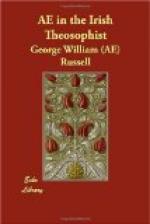It is not possible here to go into the analysis of the roots at much length: I can only illustrate the method which will be found to apply more surely where the roots express most elemental conceptions. Let us take as example the root, Wal, to boil. Boiling is brought about by the action of fire upon water, and here we find the letters W, water, and L, light or fire, united. In War, to well up as a spring, the sounds for water and motion are combined. A similar idea is expressed in Wat, to well out; the abstract significance of T, which is to evolve, come forth or appear, being here applied to a special action. A good method to follow in order to understand how the pure abstract meaning of a letter may be applied in many different ways, is to take some of the roots in which any one letter is prominent and then compare them. Let us take D. It has an abstract relation to involution or infusion; it may be view in two ways, either as positive or negative; as the exertion of force or the reception of force. Now I think if we compare the following roots a similarity of action will be found to underlie them all. Id, to swell; Ad, to eat; Dhu, to put; Da, to bind; Ad, to smell; Du, to enter; Da, to suck.
I am not here going exhaustively to analyse the roots, as this is not an essay upon philology, but an attempt to make clear some of the mysteries of sound; those who wish to study this side of the subject more fully can study with this light the primitive languages. A few more examples must suffice. The root, Mar, to die, may be variously interpreted as the end of motion, the cessation of breath, or the withdrawal of spirit, R being expressive of what on various planes is motion, spirit, air and breath. In Bur, to be active, life and movement are combined,: in Gla, to glow, reflection and light; the same idea is in Gol, a lake. We find combined in Kar, to grind, hardness and motion: in Thah, to generate, expansion and heat; in Pak, to comb, division and hardness, the suggestion being division with some hard object; the same idea is in Pik, to cut. In Pis, to pound, the letters for division and matter in its molecular state are combined: in Fath, to fly, lightness and expansion: in Yas, to gird, drawing together and number; in Rab, to be vehement, energy and life; in Rip, to break, energy




